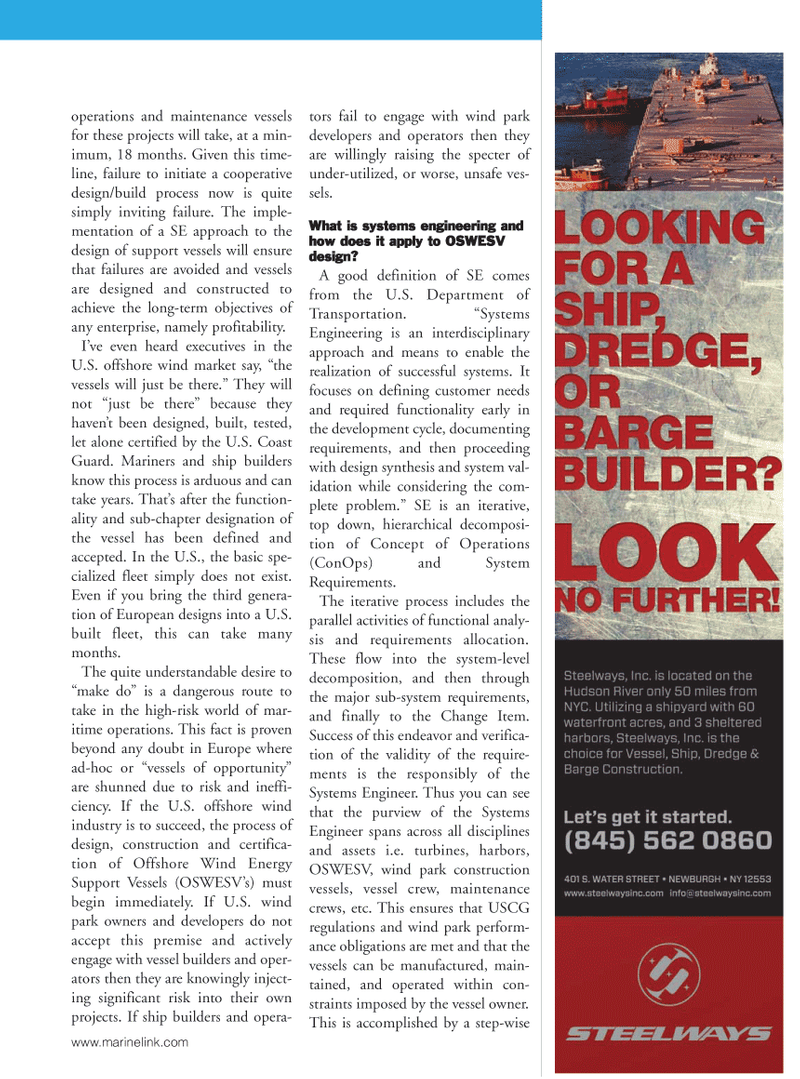
Page 23: of Marine News Magazine (February 2011)
Inland Waterways
Read this page in Pdf, Flash or Html5 edition of February 2011 Marine News Magazine
www.marinelink.com operations and maintenance vessels for these projects will take, at a min- imum, 18 months. Given this time- line, failure to initiate a cooperative design/build process now is quite simply inviting failure. The imple- mentation of a SE approach to the design of support vessels will ensure that failures are avoided and vessels are designed and constructed to achieve the long-term objectives of any enterprise, namely profitability.
I’ve even heard executives in the
U.S. offshore wind market say, “the vessels will just be there.” They will not “just be there” because they haven’t been designed, built, tested, let alone certified by the U.S. Coast
Guard. Mariners and ship builders know this process is arduous and can take years. That’s after the function- ality and sub-chapter designation of the vessel has been defined and accepted. In the U.S., the basic spe- cialized fleet simply does not exist.
Even if you bring the third genera- tion of European designs into a U.S. built fleet, this can take many months.
The quite understandable desire to “make do” is a dangerous route to take in the high-risk world of mar- itime operations. This fact is proven beyond any doubt in Europe where ad-hoc or “vessels of opportunity” are shunned due to risk and ineffi- ciency. If the U.S. offshore wind industry is to succeed, the process of design, construction and certifica- tion of Offshore Wind Energy
Support Vessels (OSWESV’s) must begin immediately. If U.S. wind park owners and developers do not accept this premise and actively engage with vessel builders and oper- ators then they are knowingly inject- ing significant risk into their own projects. If ship builders and opera- tors fail to engage with wind park developers and operators then they are willingly raising the specter of under-utilized, or worse, unsafe ves- sels.
What is systems engineering and how does it apply to OSWESV design?
A good definition of SE comes from the U.S. Department of
Transportation. “Systems
Engineering is an interdisciplinary approach and means to enable the realization of successful systems. It focuses on defining customer needs and required functionality early in the development cycle, documenting requirements, and then proceeding with design synthesis and system val- idation while considering the com- plete problem.” SE is an iterative, top down, hierarchical decomposi- tion of Concept of Operations (ConOps) and System
Requirements.
The iterative process includes the parallel activities of functional analy- sis and requirements allocation.
These flow into the system-level decomposition, and then through the major sub-system requirements, and finally to the Change Item.
Success of this endeavor and verifica- tion of the validity of the require- ments is the responsibly of the
Systems Engineer. Thus you can see that the purview of the Systems
Engineer spans across all disciplines and assets i.e. turbines, harbors,
OSWESV, wind park construction vessels, vessel crew, maintenance crews, etc. This ensures that USCG regulations and wind park perform- ance obligations are met and that the vessels can be manufactured, main- tained, and operated within con- straints imposed by the vessel owner.
This is accomplished by a step-wise

 22
22

 24
24
